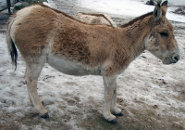Kulan - Last Wild Donkey that Refuses to be Tamed
 The Kulan (Equus hemionus) is known by many names such as the khulan, the Mongolian wild ass, the wild Asian ass and the onager. But no matter what it is called, never call this close relative of the donkey domesticated. Although there have been many attempts to tame individual kulans, all have been unsuccessful. This species refuses to bow to any master.
The Kulan (Equus hemionus) is known by many names such as the khulan, the Mongolian wild ass, the wild Asian ass and the onager. But no matter what it is called, never call this close relative of the donkey domesticated. Although there have been many attempts to tame individual kulans, all have been unsuccessful. This species refuses to bow to any master.There are six subspecies of kulan, which can all interbreed. The subspecies of kulans are similar to breeds of horses. Genetically, they carry the same amount of chromosomes but differ in appearance. The most numerous is Mongolian wild ass (Equus hemonius hemonius.) A seventh subspecies, the Syrian wild ass (Equus hemonious hemippus) went extinct in the wild in 1927. Kulans can still be found in the deserts and salt flats of northern India, Mongolia, Iran and Turkmenistan.
Physical Description
The kulan more resembles Przewalski’s horse (Equus ferus przewalskii) more than the modern donkey. Their bodies are two-toned, with a light tan or dun head, back and rump and a pale belly, muzzle and inner legs. Many have a dorsal stripe, or a dark stripe of dark brown or black running from the base of the neck to the top of the tail. In the winter, coasts become a darker red than their sleek summer coats.
Adult kulans stand 39.4 to 55 inches (1 to 1.4 meters) from the bottom of their hooves to the top of their shoulders. Stallions are usually larger and heavier than mares. Mares average 400 pounds (200 kg) and stallions tip the scales at 506 pounds (260 kg.) This is about the size of a Shetland pony. Both males and females have long ears, although not as long as a donkey’s, and stiff, upright mane.
Behavior and Herd Life
Kulans enjoy socializing with other kulans. They live in pairs or small herds. Stallions help protect their mares and foals, but over half of foals born in the wild die before they become yearlings. Foals can nurse from one to two years, depending on food availability and drought conditions. Kulans become sexually mature when they are two. Stallions from different herd or pair-bonds have been known to come together to attack wolves, their only predator outside of humans.
But the onager’s main defense is its speed, which is just as fast a thoroughbred racehorse. They can reach speeds up to 43 miles per hour (70 kilometers per hour.) But they cannot outrun bullets. Although they are a protected species, Onagers are heavily hunted for their meat and their skins. Farmers may kill kulans so their grazing animals do not have competition for food such as grasses, twigs and bark. Kulans live short lives in comparison to domestic animals. In the wild, they often die by the age of 7, but can live twice as long in captivity. Although kulans do well in zoos and safari parks, they are still wild animals. Their powerful kicks with their hind legs can severely injure or even kill a person.
Tags used in this posting
Other entries about 'asia'
- Nilgai -- The Horse-like, Camel-like Antelope
- Javan langur -- The Monkey With a Mane
- Doria's tree-kangaroo
- Douc Langur - Endangered Colorful Asian Monkey
- Banded Hare-wallaby - Endangered Marsupial Nearly Wiped Out By Cats
- European Snow Vole - Vole with the Smallest Litters
- The Northern Chinese Flying Squirrel - The Squirrel with the Medicinal Dung
- White-throated Rock-thrush - the Little Snail-Cracker
- Daurian Hedgehog - Rare Russian Hedgehog Almost Wiped Out By Pesticides
- Greater Mouse Deer - Gives Peek at What Extinct Animals Were Like
- The Japanese Macaque - Hot Springs-Loving Similian
- The Lion-Tailed Macaque - A Crying Old Man
- The Tibetan Fox - Silent Stalker of the Steppes
- Tiger - Largest cat killed by Chinese medicine?
- Puma - America's allrounder
- Proboscis monkey - The swimming star with the giant nose
- Lynx
- Indian rhinoceros - Rhino of the Asian riverscapes
Add your thoughts about this animal:
